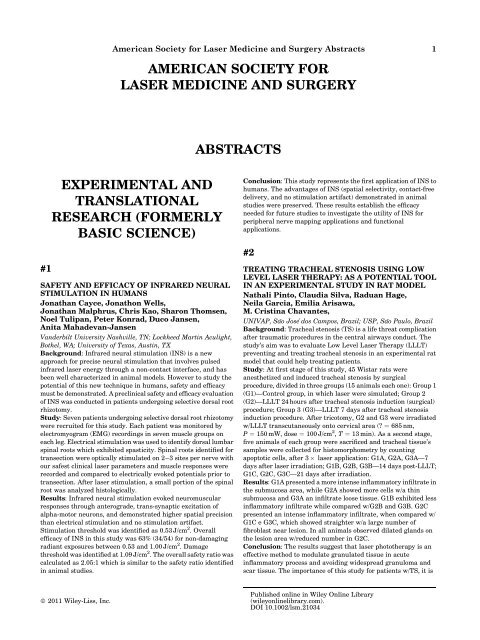Presidential Greeting - American Society for Laser Medicine and ...
Presidential Greeting - American Society for Laser Medicine and ...
Presidential Greeting - American Society for Laser Medicine and ...
Create successful ePaper yourself
Turn your PDF publications into a flip-book with our unique Google optimized e-Paper software.
#1<br />
AMERICAN SOCIETY FOR<br />
LASER MEDICINE AND SURGERY<br />
EXPERIMENTAL AND<br />
TRANSLATIONAL<br />
RESEARCH (FORMERLY<br />
BASIC SCIENCE)<br />
SAFETY AND EFFICACY OF INFRARED NEURAL<br />
STIMULATION IN HUMANS<br />
Jonathan Cayce, Jonathon Wells,<br />
Jonathan Malphrus, Chris Kao, Sharon Thomsen,<br />
Noel Tulipan, Peter Konrad, Duco Jansen,<br />
Anita Mahadevan-Jansen<br />
V<strong>and</strong>erbilt University Nashville, TN; Lockheed Martin Aculight,<br />
Bothel, WA; University of Texas, Austin, TX<br />
Background: Infrared neural stimulation (INS) is a new<br />
approach <strong>for</strong> precise neural stimulation that involves pulsed<br />
infrared laser energy through a non-contact interface, <strong>and</strong> has<br />
been well characterized in animal models. However to study the<br />
potential of this new technique in humans, safety <strong>and</strong> efficacy<br />
must be demonstrated. A preclinical safety <strong>and</strong> efficacy evaluation<br />
of INS was conducted in patients undergoing selective dorsal root<br />
rhizotomy.<br />
Study: Seven patients undergoing selective dorsal root rhizotomy<br />
were recruited <strong>for</strong> this study. Each patient was monitored by<br />
electromyogram (EMG) recordings in seven muscle groups on<br />
each leg. Electrical stimulation was used to identify dorsal lumbar<br />
spinal roots which exhibited spasticity. Spinal roots identified <strong>for</strong><br />
transection were optically stimulated on 2–3 sites per nerve with<br />
our safest clinical laser parameters <strong>and</strong> muscle responses were<br />
recorded <strong>and</strong> compared to electrically evoked potentials prior to<br />
transection. After laser stimulation, a small portion of the spinal<br />
root was analyzed histologically.<br />
Results: Infrared neural stimulation evoked neuromuscular<br />
responses through anterograde, trans-synaptic excitation of<br />
alpha-motor neurons, <strong>and</strong> demonstrated higher spatial precision<br />
than electrical stimulation <strong>and</strong> no stimulation artifact.<br />
Stimulation threshold was identified as 0.53 J/cm 2 . Overall<br />
efficacy of INS in this study was 63% (34/54) <strong>for</strong> non-damaging<br />
radiant exposures between 0.53 <strong>and</strong> 1.00 J/cm 2 . Damage<br />
threshold was identified at 1.09 J/cm 2 . The overall safety ratio was<br />
calculated as 2.05:1 which is similar to the safety ratio identified<br />
in animal studies.<br />
ß 2011 Wiley-Liss, Inc.<br />
<strong>American</strong> <strong>Society</strong> <strong>for</strong> <strong>Laser</strong> <strong>Medicine</strong> <strong>and</strong> Surgery Abstracts 1<br />
ABSTRACTS<br />
Conclusion: This study represents the first application of INS to<br />
humans. The advantages of INS (spatial selectivity, contact-free<br />
delivery, <strong>and</strong> no stimulation artifact) demonstrated in animal<br />
studies were preserved. These results establish the efficacy<br />
needed <strong>for</strong> future studies to investigate the utility of INS <strong>for</strong><br />
peripheral nerve mapping applications <strong>and</strong> functional<br />
applications.<br />
#2<br />
TREATING TRACHEAL STENOSIS USING LOW<br />
LEVEL LASER THERAPY: AS A POTENTIAL TOOL<br />
IN AN EXPERIMENTAL STUDY IN RAT MODEL<br />
Nathali Pinto, Claudia Silva, Raduan Hage,<br />
Neila Garcia, Emilia Arisawa,<br />
M. Cristina Chavantes,<br />
UNIVAP, São José dos Campos, Brazil; USP, São Paulo, Brazil<br />
Background: Tracheal stenosis (TS) is a life threat complication<br />
after traumatic procedures in the central airways conduct. The<br />
study’s aim was to evaluate Low Level <strong>Laser</strong> Therapy (LLLT)<br />
preventing <strong>and</strong> treating tracheal stenosis in an experimental rat<br />
model that could help treating patients.<br />
Study: At first stage of this study, 45 Wistar rats were<br />
anesthetized <strong>and</strong> induced tracheal stenosis by surgical<br />
procedure, divided in three groups (15 animals each one): Group 1<br />
(G1)—Control group, in which laser were simulated; Group 2<br />
(G2)—LLLT 24 hours after tracheal stenosis induction (surgical)<br />
procedure; Group 3 (G3)—LLLT 7 days after tracheal stenosis<br />
induction procedure. After tricotomy, G2 <strong>and</strong> G3 were irradiated<br />
w/LLLT transcutaneously onto cervical area (? ¼ 685 nm,<br />
P ¼ 150 mW, dose ¼ 100 J/cm 2 , T ¼ 13 min). As a second stage,<br />
five animals of each group were sacrificed <strong>and</strong> tracheal tissue’s<br />
samples were collected <strong>for</strong> histomorphometry by counting<br />
apoptotic cells, after 3 laser application: G1A, G2A, G3A—7<br />
days after laser irradiation; G1B, G2B, G3B—14 days post-LLLT;<br />
G1C, G2C, G3C—21 days after irradiation.<br />
Results: G1A presented a more intense inflammatory infiltrate in<br />
the submucosa area, while G2A showed more cells w/a thin<br />
submucosa <strong>and</strong> G3A an infiltrate loose tissue. G1B exhibited less<br />
inflammatory infiltrate while compared w/G2B <strong>and</strong> G3B. G2C<br />
presented an intense inflammatory infiltrate, when compared w/<br />
G1C e G3C, which showed straighter w/a large number of<br />
fibroblast near lesion. In all animals observed dilated gl<strong>and</strong>s on<br />
the lesion area w/reduced number in G2C.<br />
Conclusion: The results suggest that laser phototherapy is an<br />
effective method to modulate granulated tissue in acute<br />
inflammatory process <strong>and</strong> avoiding widespread granuloma <strong>and</strong><br />
scar tissue. The importance of this study <strong>for</strong> patients w/TS, it is<br />
Published online in Wiley Online Library<br />
(wileyonlinelibrary.com).<br />
DOI 10.1002/lsm.21034






